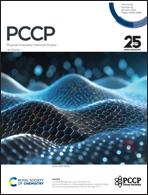Beryllium carbonyl Be(CO)n (n = 1–4) complex: a p-orbital analogy of Dewar–Chatt–Duncanson model†
Abstract
Transition metal–carbonyl bonds are rationalized by M ← CO σ donation and M → CO π back donation where the d orbital of the transition metal is involved. This bonding model provided by Dewar, Chatt and Duncanson (DCD) has rationalized many transition metal–ligand bonds. The involvement of p orbital in such a DCD model can be intriguing. Alkaline earth metals with ns2np0 configuration may appear suitable as ns0np2 excitation has been recognized in many complexes. Herein, a theoretical study is presented for the Be(CO)n (n = 1–4) complex to verify this assumption. Detailed electronic structure analyses confirmed the involvement of the p orbital of beryllium in M → CO π back donation, thereby supporting the hypothesis. EDA-NOCV results reveal that the π-back donation from the central Be atom to CO ligands significantly predominates over the σ donation from the ligands for both Be(CO)3 and Be(CO)4. Our calculations reveal that Be(CO)4 is the highest carbonyl that may be experimentally detected.



 Please wait while we load your content...
Please wait while we load your content...